14 Ducks with Red Head
You’ve spotted a stunning duck with a red head and wondering which species it might be, right? That shouldn’t be too hard to figure out, should it? After all, how many duck species really have red heads?
Across the globe, there are quite a few ducks with either fully or partially red—or reddish—heads. Most of these shades lean toward warm brown or orange tones, giving each bird a rich, earthy appearance. Here are the top 14 most common red-headed ducks.
1. Redhead

The first duck that probably comes to mind—thanks to its name—is the Redhead, with its rich, chestnut-red head. I especially enjoy spotting this species because that perfectly rounded, reddish head paired with a bluish bill makes it easy to recognize, even from a distance. Redheads are diving ducks, so don’t be surprised if you see them disappear underwater in search of plants and small creatures. They nest in freshwater wetlands across western Canada and parts of Alaska, often choosing calm marshes where cattails and reeds give them plenty of cover.
2. Canvasback
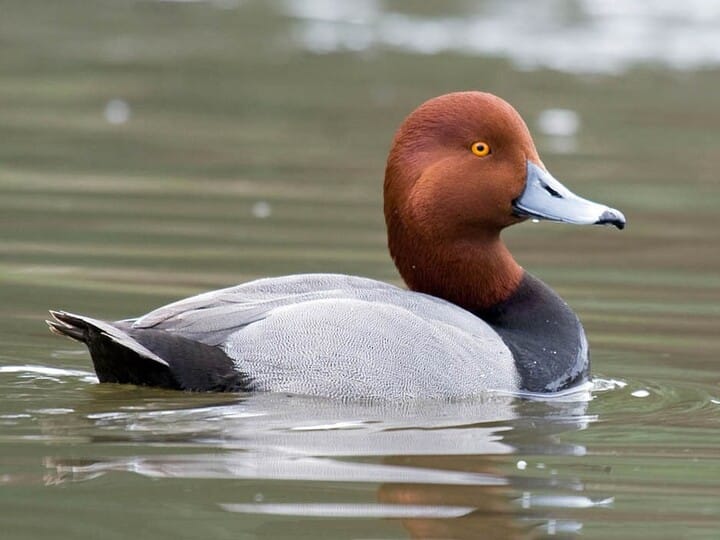
Among all the ducks with red heads on our list, the Canvasback is one you will admire instantly. The male shows off a deep, rusty-red head paired with a bright white body—almost as if he’s wearing a tuxedo. Their long, sloping forehead is a giveaway; once you’ve seen that shape, you’ll never forget it. Canvasbacks love open water and often gather in impressive flocks during migration and winter in the United States. Watch them glide across lakes and bays—they shine like little white boats drifting among the waves.
3. Common Pochard

The male Common Pochard wears a rich reddish-brown head that stands out beautifully against his pale gray body and black chest. If you’re watching a mixed flock, look for that strong contrast to help you identify him. Females are plainer, dressed in gentle gray-brown tones, but they still carry the same smooth, rounded shape. Something interesting about Common Pochards is how they feed: they often join swans, especially Bewick’s and Whoopers, to forage. The swans stir up the muddy bottom, and the pochards take advantage of the food that becomes easier to reach—a clever strategy for a smart little diver.
4. Ferruginous Duck

The Ferruginous Duck is easy to spot once you know a features to look out for: that deep, chestnut-red head that almost seems to glow in good light. Males are especially striking, with dark reddish tones across the head and body and a crisp patch of white under the tail. These ducks prefer calm, shallow lakes full of plants—places where they can dive and dabble among floating leaves. During migration and winter, they may show up in brackish pools, lagoons, or even coastal waters, so keep an eye out whenever you’re near quieter, plant-rich wetlands.
5. Red-crested Pochard
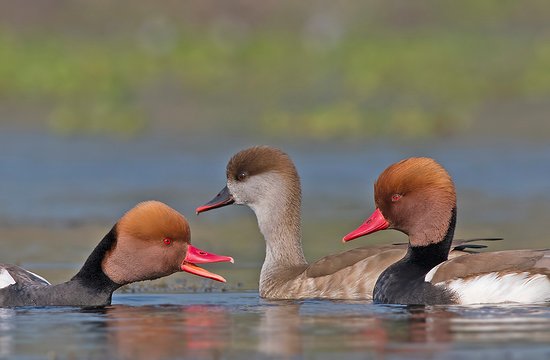
If there’s a duck that looks like it’s having a great hair day, it’s the Red-crested Pochard. The male’s head is a bright reddish-orange, almost like a glowing helmet, making it one of the boldest red-headed ducks in the world. They love broad, lowland lakes and marshes across southern Europe and into Central Asia. Many of them are migratory, flying long distances to winter in Africa or the Indian Subcontinent. If you ever spot one in winter, imagine the long journey it took to get there.
Discover other migratory ducks: 34 Migratory Ducks You Need to Know About
6. Eurasian Wigeon

The Eurasian Wigeon has a softer, paler head compared to some other red-headed ducks, but the females—especially the rufous morph—can show a warm, reddish-brown head that stands out nicely. These ducks breed far to the north, across Europe and deep into the Palearctic, nesting near tundra lakes and northern wetlands. When winter arrives, they travel south in huge numbers, heading to Africa and southern Asia. They’re also fun to watch in flocks, where their whistling calls drift across quiet lakes like little musical notes.
7. Common Merganser
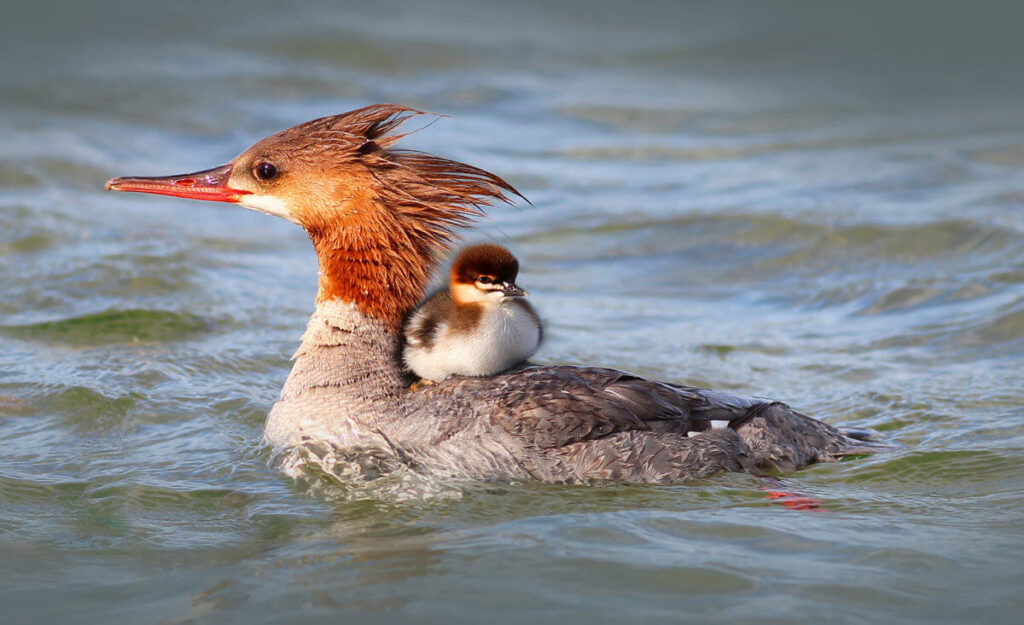
Females of the Common Merganser have a lovely rusty-cinnamon head that gives them a sleek and confident look—especially with that shaggy crest at the back. Their bodies are long and elegant, more streamlined than most ducks you might see. What really sets mergansers apart is their thin, narrow bill built for catching fish. These birds are strong swimmers and often cruise along rivers and lakes, diving suddenly to snatch their prey.
8. Cinnamon Teal

The Cinnamon Teal is a small but eye-catching duck, especially the males in breeding season. Their vivid rusty-red head and body practically glow in sunlight, while their long, dark bill gives them a slightly elegant, elongated look. Females and young ones are more uniformly brown but still carry that warm, reddish tone in subtler ways. These ducks favor shallow freshwater ponds and marshes in western North America, where they quietly feed on plants and small invertebrates. Keep an eye out for that bright red eye—it’s a tiny but unmistakable detail.
Discover other ducks with red eyes: 11 Ducks with Red Eyes You’ll Want to See for Yourself
9. Common Teal (Eurasian Teal)

The Eurasian Teal is a tiny dabbling duck with a surprisingly colorful head. Breeding males have a rich chestnut head adorned with a dark green crescent-shaped patch near the eye, bordered by fine pale lines. This mix of red, green, and white makes them a delight to spot on northern European wetlands. Though small, they are strong migrators, flying south to warmer waters in Africa and southern Asia during winter.
10. Green-winged Teal
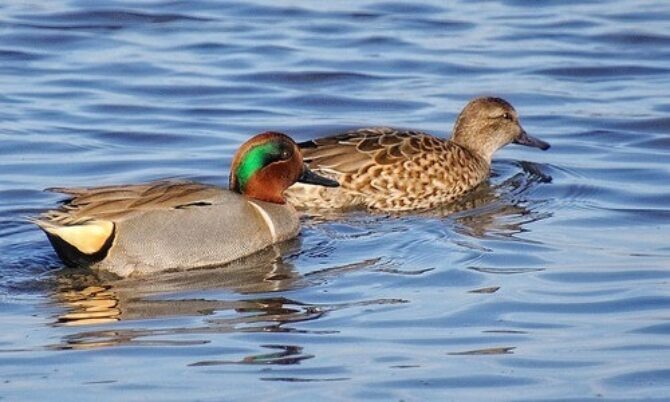
The Green-winged Teal may be one of the smallest North American ducks, but its chestnut head with a striking green eye patch ensures it doesn’t go unnoticed. Males are marked with gray flanks, a yellow rear, and a bright green speculum on the wings, making them flash in sunlight when they take flight. These teals breed across northern North America and are excellent at hiding among reeds, yet their red-brown head gives them away once you know what to look for.
11. Red-breasted Merganser

The Red-breasted Merganser earns its name from the male’s vivid red chest, but if you look closely, the females and juveniles have a rusty-red head that is just as charming. These are agile, fast-flying ducks that dive expertly to catch fish, using their serrated bills like little underwater tools. Spotting one on a lake or river is a treat, especially when they pop up with a glinting fish in their mouth. Keep an eye out for their shaggy crests—they add a bit of wild flair to an already striking head.
How many mergansers do you know? Discover more here: 7 Types of Mergansers You Should Know
12. Female Smew

The female Smew may be small, but her reddish-brown head sets her apart from other wintering ducks. She has a soft, cinnamon-colored face contrasted with a gray body, giving her a gentle, elegant look. These little divers spend much of their time in freshwater lakes and slow rivers, searching for small fish and insects. If you watch carefully, you might see her bob and dive repeatedly, showing off that smart little head in the water.
13. Amsterdam Wigeon

This one is extinct, but we cannot forget its beauty, especially the stunning red tones it had on its head. The Amsterdam Wigeon, also known as the Amsterdam Island duck, was a flightless dabbling duck endemic to Île Amsterdam in the French Southern Territories. Though we know it only from bones, it’s believed that visiting sealers and the rats they brought caused its extinction. Even in memory, its reddish head and delicate features make it a truly remarkable species, a hidden gem of the avian world that we can still admire through stories and illustrations.
14. Muscovy Duck
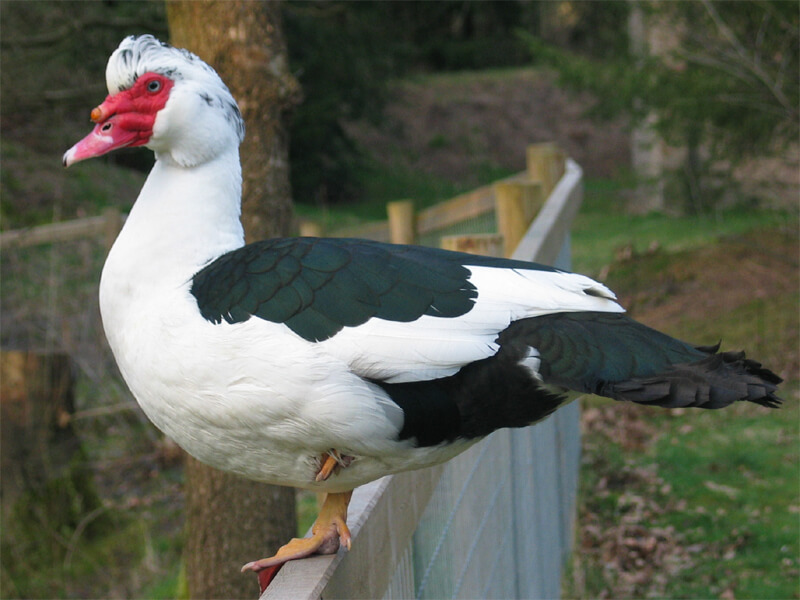
Finally, while it doesn’t have a fully red head like the others, its glossy red face and striking caruncles make it impossible to miss—and it’s sure to come to mind whenever someone mentions ducks with red heads, isn’t it? The male Muscovy Ducks are particularly impressive, with large, striking red heads that command attention. Originally from Central and South America, Muscovies are now common in many parts of the world. They prefer quiet rivers, ponds, and mangroves, and their diet includes plants, small fish, and insects.
